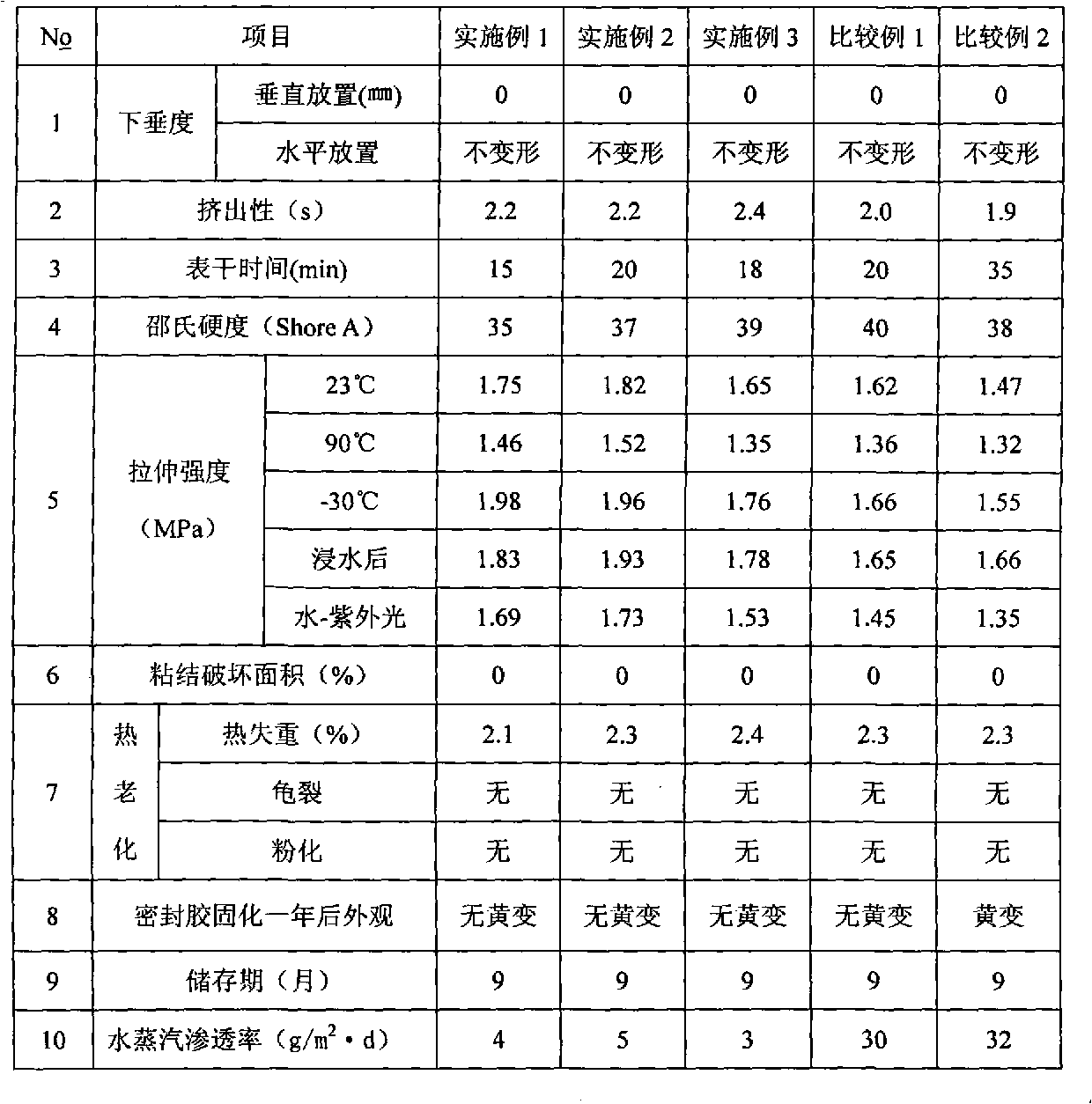Single-component silicone fluid sealant for solar energy cell assembly and manufacturing method thereof
A solar cell, silicone sealant technology, applied in electrical components, circuits, adhesives, etc., can solve problems such as affecting the appearance, water vapor mildew, etc., to prevent the growth of mold, long-term waterproof performance, and excellent adhesion. Effect
- Summary
- Abstract
- Description
- Claims
- Application Information
AI Technical Summary
Problems solved by technology
Method used
Image
Examples
Embodiment 1
[0036] Example 1: (1) Drying and dehydrating the vapor-phase white carbon black at 120°C for 2 hours; (2) The structural formula is 100 parts of α, ω-dihydroxy polydimethylsiloxane with n=100, 4 parts of petroleum resin, 40 parts of active calcium carbonate, 30 parts of silica powder, add it to the vacuum kneader, at a temperature of 150 ℃, vacuum It is 0.06MPa, dehydrated and blended for 30 minutes, and cooled to obtain the base material. At room temperature, add 3 parts of fumed white carbon black, 12 parts of methyl triisobutyl ketoxime silane, 5 parts of vinyl triisobutyl ketoxime silane, and 0.5 parts of γ-aminopropyl triethoxy silane, 1,3,5-Tris(trimethoxysilylpropyl) isocyanate 3 parts, dibutyl tin dilaurate 0.5 part, molecular terminal methyl polydimethylsiloxane with a viscosity of 0.5 Pa·s at 25°C 5 parts, add it to a high-speed dispersing mixer or planetary mixer equipped with base material, stir and react for 60 minutes at a vacuum degree of 0.09MPa and a rotating spe...
Embodiment 2
[0037] Example 2: (1) Drying and dehydrating the gas-phase white carbon black at 120°C for 2 hours; (2) The structural formula is 100 parts of α,ω-dihydroxy polydimethylsiloxane with n=500, 1 part of petroleum resin, 10 parts of active calcium carbonate, 70 parts of silica powder, add it into the vacuum kneader, at a temperature of 100°C and a degree of vacuum It is 0.09MPa, dehydrated and blended for 120 minutes, and cooled to obtain the base material. At room temperature, add 5 parts of fumed white carbon black, 10 parts of methyl triisobutyl ketoxime silane, 2 parts of vinyl triisobutyl ketoxime silane, 1 part of γ-aminopropyl triethoxy silane, 1,3,5-tris(trimethoxysilylpropyl) isocyanate 1 part, dibutyl tin dioctanoate 1 part, molecular terminal methyl polydimethylsiloxane 10 with a viscosity of 0.5 Pa·s at 25°C It is added to a high-speed dispersing mixer or planetary mixer equipped with a base material, and the reaction is stirred for 80 minutes at a vacuum degree of 0.07 M...
Embodiment 3
[0038] Example 3: (1) Drying and dehydrating the gas phase white carbon black at 120°C for 2 hours; (2) The structural formula is 100 parts of α,ω-dihydroxy polydimethylsiloxane with n=2000, 5 parts of petroleum resin, 30 parts of active calcium carbonate, 40 parts of silica powder, add into the vacuum kneader, temperature 150℃, vacuum degree It is 0.099MPa, dehydrated and blended for 200 minutes, and cooled to obtain the base material. At room temperature, add 1 part of fumed white carbon black, 5 parts of methyl triisobutyl ketoxime silane, 5 parts of vinyl triisobutyl ketoxime silane, 0.5 part of γ-aminopropyl triethoxy silane, 1,3,5-tris(trimethoxysilylpropyl) isocyanate 0.5 part, dibutyl tin dilaurate 1.5 part, molecular terminal methyl polydimethylsiloxane with a viscosity of 1.0 Pa·s at 25°C 1 part, add it to a high-speed dispersing mixer or planetary mixer equipped with base material, and stir for 120 minutes at a vacuum degree of 0.09MPa and a rotating speed of 400rpm to ...
PUM
 Login to View More
Login to View More Abstract
Description
Claims
Application Information
 Login to View More
Login to View More - R&D
- Intellectual Property
- Life Sciences
- Materials
- Tech Scout
- Unparalleled Data Quality
- Higher Quality Content
- 60% Fewer Hallucinations
Browse by: Latest US Patents, China's latest patents, Technical Efficacy Thesaurus, Application Domain, Technology Topic, Popular Technical Reports.
© 2025 PatSnap. All rights reserved.Legal|Privacy policy|Modern Slavery Act Transparency Statement|Sitemap|About US| Contact US: help@patsnap.com

